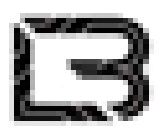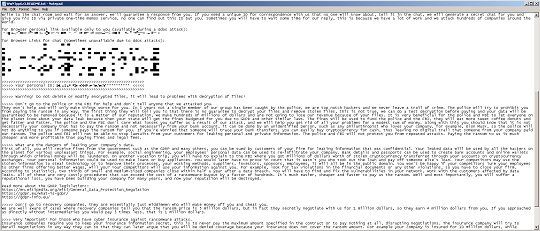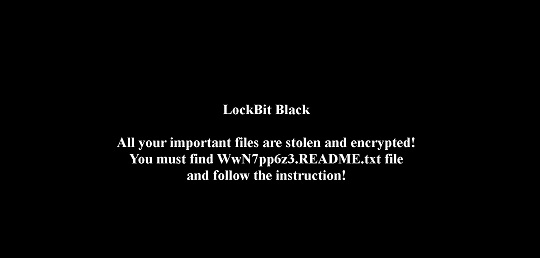Ransom.Win32.LOCKBIT.EOE
Trojan:Win32/Lockbit!ic (MICROSOFT)
Windows


Threat Type: Ransomware
Destructiveness: No
Encrypted:
In the wild: Yes
OVERVIEW
Downloaded from the Internet, Dropped by other malware
This Ransomware arrives on a system as a file dropped by other malware or as a file downloaded unknowingly by users when visiting malicious sites.
It does not have any propagation routine.
It does not have any backdoor routine.
It drops files as ransom note.
TECHNICAL DETAILS
163,328 bytes
EXE
No
16 Jun 2023
Drops files, Displays message/message boxes, Displays graphics/image, Encrypts files, Modifies system registry, Disables AV, Terminates processes
Arrival Details
This Ransomware arrives on a system as a file dropped by other malware or as a file downloaded unknowingly by users when visiting malicious sites.
Installation
This Ransomware drops the following files:
- %ProgramData%\WwN7pp6z3.ico → icon used for all encrypted files.
- %ProgramData%\WwN7pp6z3.bmp → image to set as system wallpaper after encryption.
(Note: %ProgramData% is a version of the Program Files folder where any user on a multi-user computer can make changes to programs. This contains application data for all users. This is usually C:\ProgramData on Windows Vista, 7, 8, 8.1, 2008(64-bit), 2012(64-bit) and 10(64-bit), or C:\Documents and Settings\All Users on Windows Server 2003(32-bit), 2000(32-bit) and XP.)
It adds the following processes:
- bcdedit /set {current} safeboot network → if -safe commandline parameter is used
It adds the following mutexes to ensure that only one of its copies runs at any one time:
- Global\{Generated Hash}
Autostart Technique
This Ransomware adds the following registry entries to enable its automatic execution at every system startup:
HKEY_LOCAL_MACHINE\SOFTWARE\Microsoft\
Windows\CurrentVersion\RunOnce → if -safe commandline parameter is used
{Random Characters} = {Malware Path}\{Malware File Name}
Other System Modifications
This Ransomware adds the following registry entries:
HKEY_LOCAL_MACHINE\SOFTWARE\Classes\
.WwN7pp6z3
HKEY_LOCAL_MACHINE\SOFTWARE\Classes\
WwN7pp6z3
HKEY_LOCAL_MACHINE\SOFTWARE\Classes\
WwN7pp6z3\DefaultIcon
It modifies the following registry keys:
HKEY_LOCAL_MACHINE\SOFTWARE\Classes\
.WwN7pp6z3
(Defaut) = WwN7pp6z3
HKEY_LOCAL_MACHINE\SOFTWARE\Classes\
WwN7pp6z3\DefaultIcon
(Defaut) = %ProgramData%\WwN7pp6z3.ico
HKEY_LOCAL_MACHINE\SOFTWARE\Microsoft\
Windows NT\CurrentVersion\Winlogon → if -safe commandline parameter is used
AutoAdminLogon = 1
HKEY_LOCAL_MACHINE\SOFTWARE\Microsoft\
Windows NT\CurrentVersion\Winlogon → if -safe commandline parameter is used
DefaultUserName = Administrator
HKEY_LOCAL_MACHINE\SOFTWARE\Microsoft\
Windows NT\CurrentVersion\Winlogon → if -safe commandline parameter is used
DefaultDomainName = {Computer Domain Name}
HKEY_LOCAL_MACHINE\SOFTWARE\Classes\
WwN7pp6z3 → if -safe commandline parameter is used
hScreen = {screen height}
HKEY_LOCAL_MACHINE\SOFTWARE\Classes\
WwN7pp6z3 → if -safe commandline parameter is used
wScreen = {screen width}
It changes the desktop wallpaper by modifying the following registry entries:
HKEY_CURRENT_USER\Control Panel\Desktop
WallPaper = %ProgramData%\WwN7pp6z3.bmp
HKEY_CURRENT_USER\Control Panel\Desktop
WallpaperStyle = 10
It sets the system's desktop wallpaper to the following image:
Propagation
This Ransomware does not have any propagation routine.
Backdoor Routine
This Ransomware does not have any backdoor routine.
Process Termination
This Ransomware terminates the following services if found on the affected system:
- backup
- GxBlr
- GxCIMgr
- GxCVD
- GxFWD
- GxVss
- memtas
- mepocs
- msexchange
- sophos
- sql
- svc$
- veeam
- vss
It terminates the following processes if found running in the affected system's memory:
- agntsvc
- calc
- dbeng50
- dbsnmp
- encsvc
- excel
- firefox
- infopath
- isqlplussvc
- msaccess
- mspub
- mydesktopqos
- mydesktopservice
- notepad
- ocautoupds
- ocomm
- ocssd
- onedrive
- onenote
- oracle
- outlook
- powerpnt
- sqbcoreservice
- sql
- steam
- synctime
- tbirdconfig
- thebat
- thunderbird
- visio
- winword
- wordpad
- wuauclt
- xfssvccon
Other Details
This Ransomware does the following:
- If not executed with admin rights, it will attempt to relaunch itself as admin by elevating its privileges via bypassing UAC
- It encrypts fixed, removable and network shares
- It deletes files in recycle bin folder for removable and fixed drives
- It uses WQL to delete shadow copies
- It renames itself 26 times before deleting itself after encryption
- It has the capability to print the ransom note in infected machines
- It terminates if the machine has the following system language:
- Arabic (Syria)
- Armenian (Armenia)
- Azerbaijani (Cyrillic Azerbaijan)
- Azerbaijani (Latin Azerbaijan)
- Belarusian (Belarus)
- Georgian (Georgia)
- Kazakh (Kazakhstan)
- Kyrgyz (Kyrgyzstan)
- Russian (Moldova)
- Russian (Russia)
- Tajik (Cyrillic Tajikistan)
- Tatar (Russia) Romanian (Moldova)
- Turkmen (Turkmenistan)
- Ukranian (Ukraine)
- Uzbek (Cyrillic Uzbekistan)
- Uzbek (Latin Uzbekistan)
- It deletes the following services:
- WdBoot
- WdFilter
- WdNisDrv
- WdNisSvc
- WinDefend
- wscsvc
- sppsvc
- Sense
- SecurityHealthService
- It changes the encrypted file icon to the following image:

- It avoids encrypting files with the following file extensions:
- 386
- adv
- ani
- bat
- bin
- cab
- cmd
- com
- cpl
- cur
- deskthemepack
- diagcab
- diagcfg
- diagpkg
- dll
- drv
- exe
- hlp
- hta
- icl
- icns
- ico
- ics
- idx
- key
- ldf
- lnk
- lock
- mod
- mpa
- msc
- msi
- msp
- msstyles
- msu
- nls
- nomedia
- ocx
- pdb
- prf
- ps1
- rom
- rtp
- scr
- search-ms
- shs
- spl
- sys
- theme
- themepack
- wpx
It accepts the following parameters:
- -safe →Reboots in safeboot, then encrypts the user's machine
- -wall → Changes system Wallpaper and Print ransom note on printers then deletes itself after renaming for 26 times.
- -path {target} → Specifically encrypt the target, can be file or folder
- -gspd → Perform Group Policy Modification for Lateral Movement
- -psex → Lateral Movement via Admin Shares
- -gdel → Delete group policy updates
- -del → Deletes itself after renaming for 26 times.
Ransomware Routine
This Ransomware avoids encrypting files with the following strings in their file name:
- autorun.inf
- boot.ini
- bootfont.bin
- bootsect.bak
- d3d9caps.dat
- desktop.ini
- GDIPFONTCACHEV1.DAT
- iconcache.db
- ntldr
- ntuser.dat
- ntuser.dat.log
- ntuser.ini
- thumbs.db
It avoids encrypting files found in the following folders:
- $recycle.bin
- $windows.~bt
- $windows.~ws
- all users
- boot
- config.msi
- default
- intel
- microsoft
- msocache
- perflogs
- program files
- program files (x86)
- programdata
- public
- system volume information
- tor browser
- windows
- windows.old
- x64dbg
It renames encrypted files using the following names:
- {Random Characters}.WwN7pp6z3
It drops the following file(s) as ransom note:
- {Encrypted Directory}\WwN7pp6z3.README.txt

SOLUTION
9.800
18.520.03
20 Jun 2023
18.521.00
21 Jun 2023
Step 1
Trend Micro Predictive Machine Learning detects and blocks malware at the first sign of its existence, before it executes on your system. When enabled, your Trend Micro product detects this malware under the following machine learning name:
- Troj.Win32.TRX.XXPE50FFF069
Step 2
Before doing any scans, Windows 7, Windows 8, Windows 8.1, and Windows 10 users must disable System Restore to allow full scanning of their computers.
Step 3
Note that not all files, folders, and registry keys and entries are installed on your computer during this malware's/spyware's/grayware's execution. This may be due to incomplete installation or other operating system conditions. If you do not find the same files/folders/registry information, please proceed to the next step.
Step 4
Restart in Safe Mode
Step 5
Delete this registry value
Important: Editing the Windows Registry incorrectly can lead to irreversible system malfunction. Please do this step only if you know how or you can ask assistance from your system administrator. Else, check this Microsoft article first before modifying your computer's registry.
- In HKEY_LOCAL_MACHINE\SOFTWARE\Microsoft\Windows\CurrentVersion\RunOnce
- {Random Characters} = {Malware Path}\{Malware File Name}
- {Random Characters} = {Malware Path}\{Malware File Name}
- In HKEY_LOCAL_MACHINE\SOFTWARE\Classes\.WwN7pp6z3
- (Defaut) = WwN7pp6z3
- (Defaut) = WwN7pp6z3
- In HKEY_LOCAL_MACHINE\SOFTWARE\Classes\WwN7pp6z3\DefaultIcon
- (Defaut) = %ProgramData%\WwN7pp6z3.ico
- (Defaut) = %ProgramData%\WwN7pp6z3.ico
- In HKEY_LOCAL_MACHINE\SOFTWARE\Microsoft\Windows NT\CurrentVersion\Winlogon
- AutoAdminLogon = 1
- AutoAdminLogon = 1
- In HKEY_LOCAL_MACHINE\SOFTWARE\Microsoft\Windows NT\CurrentVersion\Winlogon
- DefaultUserName = Administrator
- DefaultUserName = Administrator
- In HKEY_LOCAL_MACHINE\SOFTWARE\Microsoft\Windows NT\CurrentVersion\Winlogon
- DefaultDomainName = {Computer Domain Name}
- DefaultDomainName = {Computer Domain Name}
- In HKEY_LOCAL_MACHINE\SOFTWARE\Classes\WwN7pp6z3
- hScreen = {screen height}
- hScreen = {screen height}
- In HKEY_LOCAL_MACHINE\SOFTWARE\Classes\WwN7pp6z3
- wScreen = {screen width}
- wScreen = {screen width}
Step 6
Delete this registry key
Important: Editing the Windows Registry incorrectly can lead to irreversible system malfunction. Please do this step only if you know how or you can ask assistance from your system administrator. Else, check this Microsoft article first before modifying your computer's registry.
- In HKEY_LOCAL_MACHINE\SOFTWARE\Classes\.WwN7pp6z3
- In HKEY_LOCAL_MACHINE\SOFTWARE\Classes\WwN7pp6z3
Step 7
Search and delete this file
- %ProgramData%\WwN7pp6z3.ico
- %ProgramData%\WwN7pp6z3.bmp
- {Encrypted Directory}\WwN7pp6z3.README.txt
Step 8
Restart in normal mode and scan your computer with your Trend Micro product for files detected as Ransom.Win32.LOCKBIT.EOE. If the detected files have already been cleaned, deleted, or quarantined by your Trend Micro product, no further step is required. You may opt to simply delete the quarantined files. Please check this Knowledge Base page for more information.
Step 9
Restore encrypted files from backup.
Step 10
Reset your Desktop properties
Step 11
Scan your computer with your Trend Micro product to delete files detected as Ransom.Win32.LOCKBIT.EOE. If the detected files have already been cleaned, deleted, or quarantined by your Trend Micro product, no further step is required. You may opt to simply delete the quarantined files. Please check the following Trend Micro Support pages for more information:
Did this description help? Tell us how we did.


